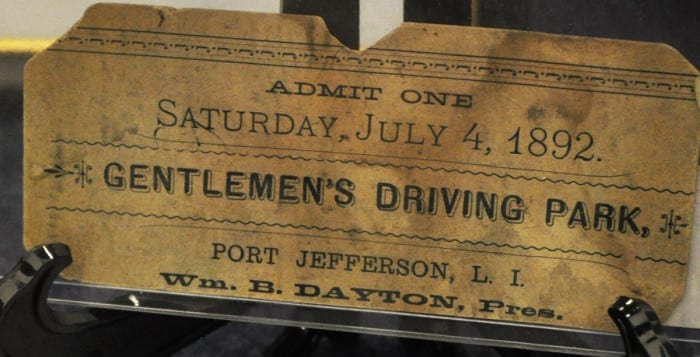What was once an abandoned and forgotten horse racing track in a stretch of woods in Terryville is now a Brookhaven-designated historic landmark.
The town board voted unanimously during its May 11 meeting to recognize the Gentlemen’s Driving Park, the last Victorian-era harness racing track on Long Island, as an historic landmark and by doing so, solidified the hard work of the local residents and elected officials who helped to make it happen.

The half-mile track, before it became hidden among trees, was a popular gathering place for bettors in the late 19th century to watch men race around the loop behind horses in carts. It was part of a circuit of tracks in the Northeast — others sat in Smithtown, Setauket and Riverhead — and is the last remaining one.
“I urge you to recognize it,” Barbara Russell, Brookhaven town historian, said before the board made their decision.
Russell played a huge part in providing historical context to the site when Jack Smith, president and founder of the Cumsewogue Historical Society, initially kicked off the project more than a year ago.
She made all resources of her office available to the historical society, including original photographs of the track donated by the historic Davis family and firsthand accounts of these races through old letters.
Smith discovered the faint outline of the horse track from a satellite image on Google Earth upon hearing of its existence off Canal Road, and eventually went to the site with his wife Pam, to examine it more closely. To his delight, he ended up finding pieces of Long Island history scattered throughout the 11-acre site, including a broken pair of Victorian-era field glasses close to where the finish line of the track would’ve been as well as a race day ticket from 1892.
Smith then reached out to former Councilman Steve Fiore-Rosenfeld and other council members about acquiring the site, clearing the overgrown path and restoring it. Rosenfeld, Smith said, saw the value in preserving the site and laid the groundwork to make the project possible.
The Gentlemen’s Driving Park officially opened to the public in October.
“The landmark status recognizes the importance of preserving this colorful and almost forgotten part of Brookhaven Town’s history,” Smith said in a phone interview. “The driving park is now a collective symbol of the many large driving parks that once dotted the Long Island landscape … Long Island being the birthplace of horse racing in America. I’m happy the society as a whole was able to play an integral part in getting this important part of our history preserved.”

Smith said Councilwoman Valerie Cartright (D-Port Jefferson Station) picked up where Rosenfeld left off when she was first elected.
“She took it through some difficult negotiations and brought the whole thing to fruition,” he noted. “Her diligence and hard work, tremendous optimism and skill in bringing everything together have culminated in the preservation … .”
Cartright expressed her excitement about the designation in an emailed statement. She described the endeavor as a three-step process — first the town’s acquisition of the park in 2014, then the reopening in 2016, and finally receiving the landmark designation last week.
“During each of these steps, and for several years prior to my taking office, Jack Smith has been at the forefront of the Gentlemen’s Driving Park project,” she said. “The activism, research and unwavering support of Jack and the Historical Society has been an inspiration. The historic landmark status draws additional attention to Gentlemen’s Driving Park and is an honor the rich history of the location and all those who helped preserve it certainly deserve.”
Smith said the town plans to build a Victorian-style gate as an entranceway to the track.























